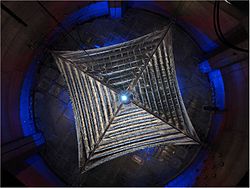Sunjammer (spacecraft)
 Sunjammer as seen from the top of the vacuum chamber where it was tested | |
| Names | Solar Sail Demonstrator |
|---|---|
| Operator | NASA |
| Website | The Sunjammer Project |
| Spacecraft properties | |
| Manufacturer | LGarde |
| Launch mass | 32 kilograms (70 lb) |
| Dimensions | 124 by 124 feet (38 by 38 m) |
| Start of mission | |
| Launch date | Cancelled (planned for January 2015) |
| Rocket | Falcon 9 |
| Launch site | Cape Canaveral Air Force Station |
Sunjammer (Solar Sail Demonstrator) was a NASA mission intended to demonstrate a solar sail constructed by LGarde, but was cancelled before launch. The largest solar sail made as of 2013, Sunjammer was named after a 1964[1] Arthur C. Clarke story of the same name, Sunjammer, in which several solar sails compete in a race across the Solar System.[2] Sunjammer was slated to launch in January 2015 as the secondary payload of a SpaceX Falcon 9 rocket, along with the Earth observation satellite DSCOVR.[2] Citing a lack of confidence in its contractor’s ability to deliver, the mission was cancelled in October 2014.[3]
Spacecraft design
Constructed of Kapton in order to withstand the extreme temperatures of space, Sunjammer has a width and height of 38 metres (124 ft), giving it a total surface area of over 1,200 square metres (13,000 sq ft) and making it the largest solar sail as of 2013.[4] Despite its huge surface area, Sunjammer has a thickness of only 5 μm, giving it an extremely low weight of about 32 kilograms (70 lb) and allowing it to be stored in a space the size of a dishwasher.[4] Once in space, the large surface area of the solar sail would allow it to achieve a thrust of about 0.01 N—roughly the weight of a sugar packet.[5] To control its orientation, and via this its speed and direction, Sunjammer was to use gimballed vanes (each of which is itself a small solar sail) located at the tips of each of its 4 booms, instead of thrusters, completely eliminating the need for any propellant other than the rays of the Sun.[5]
In addition to being a demonstration craft, Sunjammer was to collect scientific data in its own right. With several instruments to detect various aspects of space weather, Sunjammer could have eventually become part of a larger network of solar sails studying the Sun, allowing for the creation of a more robust early-warning system for space weather.[2]
Mission
Prior to its cancellation, Sunjammer was slated for launch in January 2015 aboard a Falcon 9 rocket, a slight delay from an earlier projection of November 2014. It was to launch as a secondary payload along with the primary DSCOVR Earth observation and space weather satellite.[2] Within two months of launch the spacecraft was to test various technologies, such as deployment, vector control via altitude vanes, and eventually reaching a location near the Earth-Sun L1 Lagrangian point.[4]
Payloads
Sunjammer was to carry two British space science payloads: the Solar Wind Analyser (SWAN) developed by the Mullard Space Science Laboratory of University College London,[6] and the MAGIC magnetometer developed by the Blackett Laboratory of Imperial College London.[7][8]
Sunjammer was to carry a Celestis Memorial Spaceflight payload of cremated remains.[9]
References
- ^ Clarke, Arthur C. "Short Stories". ArthurCClarke.net. Retrieved June 14, 2013.
- ^ a b c d Wall, Mike (June 13, 2013). "World's Largest Solar Sail to Launch in November 2014". Space.com. TechMediaNetwork. Retrieved June 14, 2013.
- ^ Leone, Dan (October 17, 2014). "NASA Nixes Sunjammer Mission, Cites Integration, Schedule Risk". spacenews.com.
- ^ a b c David, Leonard (January 31, 2013). "World's Largest Solar Sail to Launch in November 2014". Space.com. TechMediaNetwork. Retrieved June 15, 2013.
- ^ a b Brooke, Boen, ed. (December 16, 2011). "Solar Sail Demonstration (The Sunjammer Project)". Technology Demonstration Missions. NASA. Retrieved June 15, 2013.
- ^ Sunjammer team to present latest solar sail technology
- ^ Dr. Jonathan Eastwood, Imperial College London
- ^ Sunjammer spacecraft to 'sail' towards the sun - Telegraph
- ^ "SUNJAMMER MISSION PARTNERS ANNOUNCED for GIANT NASA SOLAR SAIL LAUNCH" (PDF). sunjammermission.com Press Release. June 4, 2013.
External links
- Sunjammer Solar Sail Mission Sunjammermission.com web site
- Sunjammer L'Garde Inc. Sunjammer page
- Solar Sail Demonstration (The Sunjammer Project) NASA Sunjammer Mission page
- The Sunjammer Solar Sail: Making Your Loved One Part of Space History Celestis Sunjammer page
- Sunjammer Space and Atmospheric Physics Group, Imperial College London
